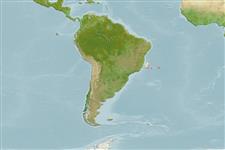>
Eupercaria/misc (Various families in series Eupercaria) >
Scaridae (Parrotfishes) > Sparisomatinae
Etymology: Sparisoma: Latin, sparus = a fish with a golden head + Greek, soma = body (Ref. 45335); rocha: Named for Luiz A. Rocha and additionally 'rocha' means rock in Portuguese, alluding to the volcanic rocky formation of Trindade Island (its type locality); noun in apposition.
Eponymy: Dr Luiz Alvez Rocha is a Brazilian ichthyologist and Associate Curator of Ichthyology and Follett Chair of Ichthyology at the California Academy of Sciences. [...] (Ref. 128868), visit book page.
Environment: milieu / climate zone / rango de profundidad / distribution range
Ecología
marino asociado a arrecife; rango de profundidad 10 - 25 m (Ref. 84274). Tropical
Southwestern Atlantic: off Brazil, Trindade Island.
Tamaño / Peso / Age
Madurez: Lm ? range ? - ? cm
Max length : 30.5 cm SL macho / no sexado; (Ref. 114982)
Short description
Claves de identificación | Morfología | Morfometría
Espinas dorsales (total) : 9; Radios blandos dorsales (total) : 10; Espinas anales: 3; Radios blandos anales: 9. This species is distinguished from its Southwestern Atlantic congeners by the following unique colour characters: initial phase (IP) is red overall with a brownish shade from lower jaw to over the abdominal cavity, sparse orange blotches on head, and a pale circumpeduncular band. The terminal phase (TP) on the other hand is reddish brown with orange stripe from jaw angle to end of preopercle, sparse orange blotches on head, with 3 pinkish to reddish stripes from about midline to dorsum, from midline to belly pale greyish green to whitish with suffusion of pale reddish brown, a black spot on base of pectoral fins and a bright-yellow blotch below this spot. Furthermore, mitochondrial 12S and 16S rRNA loci sequences do not match any known Sparisoma species (Ref. 84274).
This species is a scraper and has been recorded to graze upon epilithic algae growing on rocky and calcareous substrata at 10-25 m depth. The males are solitary, whereas the females may be seen alone or in couples and accompanied by juveniles. These juveniles are small, about 2-5 cm, and associate with mixed groups of the labrids Halichoeres penrosei and Thalassoma noronhanum, which have a similar colour pattern. This association may be considered as a form of social mimicry (Ref. 84274).
Life cycle and mating behavior
Madurez | Reproducción | Puesta | Huevos | Fecundidad | Larva
Pinheiro, H.T., J.L. Gasparini and I. Sazima, 2010. Sparisoma rocha, a new species of parrotfish (Actinopterygii: Labridae) from Trindade Island, South-western Atlantic. Zootaxa 2493:59-65. (Ref. 84274)
IUCN Red List Status (Ref. 130435: Version 2025-1)
Threat to humans
Harmless
Human uses
Herramientas
Special reports
Download XML
Fuentes de Internet
Estimates based on models
Preferred temperature (Referencia
123201): 25.5 - 27.4, mean 25.8 °C (based on 4 cells).
Phylogenetic diversity index (Referencia
82804): PD
50 = 0.5000 [Uniqueness, from 0.5 = low to 2.0 = high].
Bayesian length-weight: a=0.01148 (0.00683 - 0.01929), b=3.10 (2.96 - 3.24), in cm total length, based on LWR estimates for this species & Genus-body shape (Ref.
93245).
Nivel trófico (Referencia
69278): 2.0 ±0.1 se; based on size and trophs of closest relatives
Resiliencia (Referencia
120179): Medio, población duplicada en un tiempo mínimo de 1.4-4.4 años (Preliminary K or Fecundity.).
Fishing Vulnerability (Ref.
59153): Low to moderate vulnerability (27 of 100).
🛈
